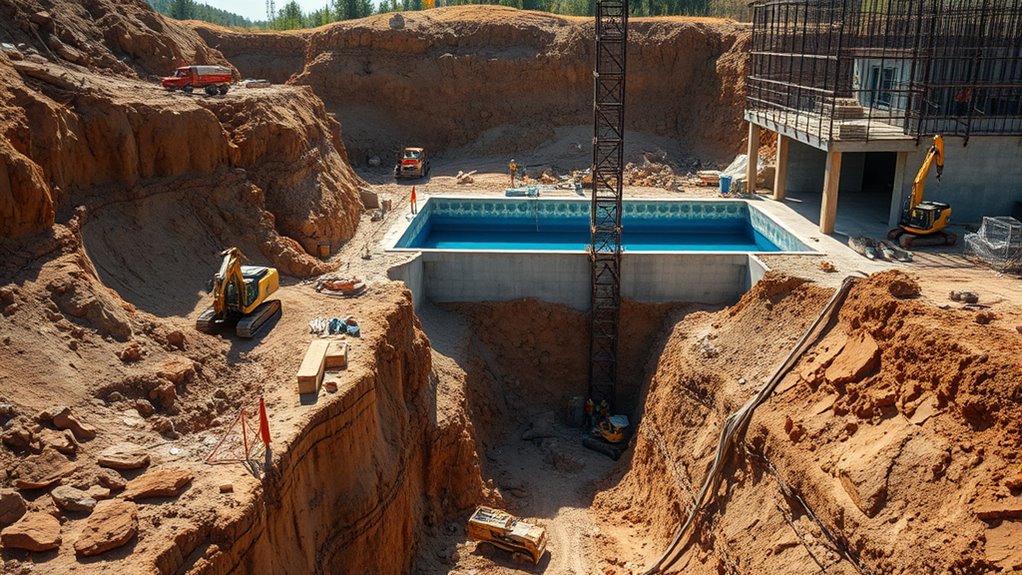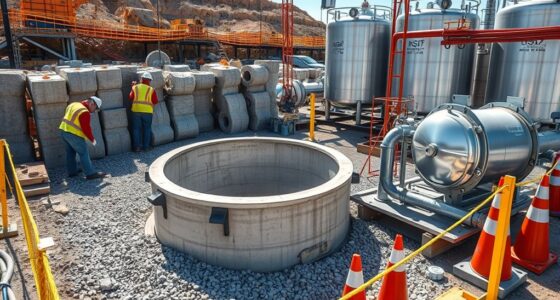Once you finalize your design and secure permits, you’ll clear and level the site for excavation, then build the pool shell while installing plumbing and electrical systems. After construction, finishing touches like tile, coping, and decking are added. The final steps involve thorough testing, filling the pool, and inspecting all systems before you can enjoy your first swim. Keep going to discover detailed tips that help guarantee a smooth, successful pool build from start to finish.
Key Takeaways
- Secure necessary permits and finalize pool design before starting site preparation.
- Clear and level the site, then excavate according to design specifications.
- Construct the pool shell and install plumbing and electrical systems concurrently.
- Apply finishing touches such as tile, coping, and decking after shell and systems are complete.
- Test all systems, fill the pool, and conduct final inspections before hosting the first swim.

A well-planned construction timeline is essential for ensuring your project stays on track and within budget. When you’re dreaming of that perfect backyard oasis, understanding the key steps from initial planning to the first swim can make all the difference. One of the first things you’ll need to focus on is pool design. This phase involves working closely with designers or architects to finalize the shape, size, and features of your pool. Your pool design should reflect both your aesthetic preferences and your functional needs, whether you’re aiming for a sleek modern look or a naturalistic lagoon. Once you’ve nailed down the design, it’s time to move forward with securing the necessary construction permits.
Securing construction permits is a critical step that can’t be overlooked. These permits ensure your project complies with local regulations and safety standards. The process can sometimes take longer than expected, so it’s advisable to submit your applications early in the planning phase. Depending on your location, you might need permits for excavation, electrical work, plumbing, and other aspects of construction. Working with a licensed contractor can help streamline this process, as they are familiar with local requirements and can handle the permit applications on your behalf. Failing to obtain the proper permits can result in costly delays or even having to dismantle work that was done without approval.
Once permits are approved, your construction timeline will include site preparation. This involves clearing the area, leveling the ground, and setting the foundation for your pool. It’s imperative to stay on schedule here because delays in site prep can cascade into later stages. After site prep, excavation begins, where heavy machinery digs out the space according to your pool design specifications. During this stage, your contractor will also coordinate with other trades, such as electricians and plumbers, to ensure the infrastructure is in place before the shell is installed. This coordination is crucial; missteps here can cause setbacks. Additionally, understanding the technology involved in modern pool construction can help you appreciate the importance of integrated systems like efficient plumbing and electrical work.
Following excavation, the construction of the pool shell, plumbing, and electrical systems takes priority. Once the shell is in place, the focus shifts to finishing touches like tile, coping, and decking. Throughout each phase, regular communication with your contractor helps keep the project moving smoothly and allows you to address issues promptly. By sticking to a detailed timeline, you can anticipate the timeline for filling the pool, testing systems, and finally, the moment you’ve been waiting for: your first swim. Staying organized and proactive from the initial pool design to the day you dive in ensures your backyard retreat becomes a reality without unnecessary stress or delays.
Frequently Asked Questions
How Long Does Each Construction Phase Typically Take?
You’ll find that each construction phase varies, but generally, project milestones like site prep and pool installation take a few weeks each. After selecting your contractor, the process speeds up, with excavation taking about one to two weeks and concrete work around another two. Final touches and inspections may add a week or two. Staying on schedule depends on clear communication and timely approvals throughout each phase.
What Permits Are Required Before Beginning Construction?
Think of your project as a quest where permits are your map. You’ll need permit requirements, including building and environmental permits, to proceed. Zoning approvals are essential to make certain your pool aligns with local regulations. Check with your city or county office early to gather all necessary documents. Securing these permits before starting construction prevents delays, keeping your journey smooth from dig to the first swim.
How Is Construction Progress Communicated to Stakeholders?
You keep stakeholders informed by providing regular updates on project milestones through emails, meetings, or digital dashboards. You highlight key progress points, like excavation completion or pool installation, ensuring everyone stays aligned. Using clear, concise stakeholder updates helps manage expectations and addresses concerns promptly. By maintaining transparent communication, you foster trust and keep everyone engaged throughout the construction process, from the initial dig to the first swim.
What Unexpected Delays Can Affect the Timeline?
Unexpected delays like weather setbacks and labor shortages can considerably impact your construction timeline. Bad weather, such as heavy rain or storms, can halt work temporarily, while labor shortages may slow progress or cause scheduling conflicts. You should stay flexible and communicate regularly with your team to adjust plans accordingly. By staying proactive, you can minimize the impact of these delays and keep your project on track for a timely completion.
How Is Quality Control Maintained Throughout Construction?
Think of quality control as the steady heartbeat of your project. You actively implement inspection protocols and rigorous quality assurance measures at every stage, ensuring standards are met. Regular site inspections, testing materials, and documenting progress keep everything on track. This vigilant approach acts like a shield, catching issues early and maintaining high quality from foundation to finish, so your pool is built to last and meet your expectations.
Conclusion
As you watch the final splash, remember each step—digging deep, shaping dreams, raising hopes—was part of a larger rhythm. Like the steady beat of a heart or the gentle flow of water, your patience and effort have created a space for new beginnings. This timeline isn’t just about construction; it’s a symbol of growth, transformation, and the promise of future memories. Now, with the first swim, your journey flows seamlessly into endless possibilities.









